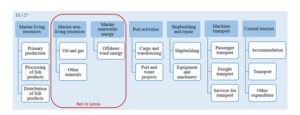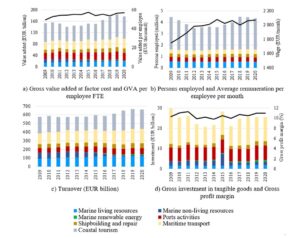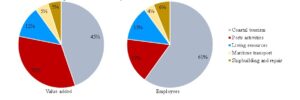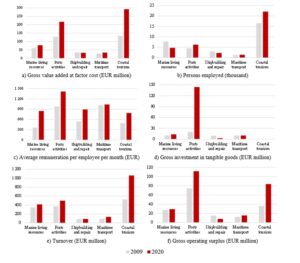Introduction
The concept ‘blue economy’ encompasses all the economic activities related to oceans, seas and coastal territories and such sectors as fishery, shipbuilding, and coastal tourism, as well as blue biotechnologies and generating energy from offshore renewable sources of energy (European Commission, 2022d). It covers the companies that produce the goods or provide the services facilitating the maritime economy operating both
in the marine environment and at land. The blue economy includes many promising companies in their initial stage of operation, which are often established owing to the research and development programs funded by the EU. These companies develop solutions related to the energy from the renewable energy sources, sustainable marine goods, blue biotechnology, marine information technology, etc.
Over the last decade, the blue growth has received increasing attention and has become the major issue of policy makers, and three major international organizations focused on it: the EU, the United Nations and the Organisation for Economic Co-operation and Development (UNEP, et at., 2012; OECD, 2016; European Commission, 2022b). Facilitation of the blue economy development is a priority area not only in the EU, but also in Latvia. The blue economy facilitates a coordinated use of marine resources with the necessity to ensure economic growth and employment. The potential of seas and oceans can facilitate the European economy, in addition, they are characterized by a great innovative and growth potential. The importance of the blue economy in the sustainable development of the national economy of the EU countries is considerably increasing and provides for a significant contribution into the conservation of the environment and climate (World Wildlife Fund, 2015). The blue economy is an integral part of the economic policies of the EU countries, and it can facilitate sustainable development of national economy.
The blue economy of the EU is facilitated through various instruments. European Fund for Strategic Investments has invested more than EUR 1.4 billion in the offshore wind energy projects and provided a considerable support for other sectors of the blue economy, including the development of ports and clean shipping. The BlueInvest platform managed by the European Commission and the European Investment Fund is strategically focused on innovative blue economy and supports it; the platform allocated EUR 22 million in 2019 and EUR 20 million in 2020 as grants. Several projects of blue economy are also financed by the European Bank for Reconstruction and Development (European Commission, 2022a). Moreover, there was developed the EU Blue Growth Strategy to strengthen sustainable growth in the field of maritime affairs and the sector maritime economy in general (European Commission, 2017). The Strategy acknowledges that seas and oceans stimulate the European national economy, besides, they are characterized by a large innovative and growth potential. Research and innovation are the key pillars of the Strategy, which is the ground for the activity of Europe in this field (European Commission, 2017).
The development of a sustainable blue economy plays a key role in aspirations to achieve the Goal 14 of the UN to “conserve and sustainably use the oceans, seas and marine resources for sustainable development” (United Nations, 2021). The EU, who is the leader in the field of ocean energy technologies, is heading the goal of producing up to 35% of its electricity from the offshore sources no later than 2050 (European Commission, 2022a). The blue economy enables the coordination of the use of marine resources with the need to ensure economic growth and employment in communities. The energy obtained from the renewable marine sources, food from the sea, sustainable coastal and marine tourism, blue bioeconomy, and many other activities that build up the blue economy, can facilitate a sustainable development of the national economy (European Commission, 2017). Blue economy is an integral part of the EU’s economic policies, the significance of which is increasing in Latvia, too. It offers a considerable potential for economic growth, sustainable transition, and job-creation.
Research aim – to evaluate the development of the blue economy in Latvia. To reach the aim, the following work tasks were put forward: 1) to select indicators for evaluation of the blue economy development; 2) to carry out a socio-economic assessment of the blue economy sectors in the EU; 3) to evaluate the growth opportunities of the blue economy in Latvia. The research provides an insight into the measures to be implemented further, to facilitate blue economy development. The reflected information may be used in decision making to establish, implement and plan the common policy of the blue economy.
There were used quantitative research methods in the research. The author mostly applied analysis and synthesis methods in the development of conclusions and proposals. Microsoft Excel, Microsoft PowerPoint and IrfanView program were used in the processing and analysis of the research results.
Materials and Methods
In the EU, there are seven blue economy sectors, these are: 1) marine living resources; 2) marine non-living resources; 3) marine renewable energy; 4) port activities; 5) shipbuilding and repair; 6) maritime transport; 7) coastal tourism (Fig. 1.). The Latvian national economy includes all the sectors of the blue economy as in the EU, except for the sector of marine non-living resources and the sector of marine renewable energy.
The study will deal with the analysis of the blue economy sectors in the EU-27 and Latvia, based on the following indicators describing the socio-economic situation: gross value added at factor cost, persons employed, average remuneration per employee per month, turnover, gross investment in tangible goods, gross profit margin and gross operating surplus.

Fig. 1. The sectors and sub-sectors of the blue economy in the EU-27 and Latvia (created by the author according to Institute of Agricultural Resources and Economics, 2020; European Commission, 2022d)
The analysis covers the period between 2009 and 2020. The availability and quality of the data determined the level of details and the results.
Results and Discussion
Development of Blue Economy in the EU
In the member states of the EU, the turnover of the blue economy in 2020 amounted to EUR 661 billion, and it ensured less than 2% of the total GDP in the EU and employed 4.37 million people (Fig. 2). Although employment has not changed significantly since 2009, the level of employee remuneration has increased by 18%, reaching the boundary of EUR 2,071 per month in 2020.

Fig. 2. EU-27 blue economy development indicators between 2009 and 2020 (calculated and created by the author according to the European Commission, 2022c)
Annually, ~ EUR 26 billion is invested in the development of the EU’s blue economy. During this period, the largest investments were made in the development of the sector of maritime transport (on average EUR 12.03 billion every year) suggesting that the sector has high growth potential. Although there was no investment in tangible goods in coastal tourism, this sector is much more socio-economically developed than other sectors of the EU’s blue economy, which can be attributed to the availability of natural resources and cultural heritage and their use in entrepreneurship. Between 2009 and 2020, the return on investments into the EU’s blue economy has been profitable and steady every year with gross profit margin ranging from 9.80 to 11.30%.
The blue economy in the EU is experiencing a smooth development – the value added has increased by 18% and by 15% per person employed since 2009. The growth of the blue economy in the EU was mainly facilitated by the development of the coastal tourism sector as well as the increase in the number of working places in the sector of marine renewable energy – 9 times in less than 10 years.
The blue economy is the most developed in Germany, Spain, Italy, and France. In these countries, the blue economy stands out with both high added value and high employment (Fig. 3). Although Greece ranks only 7th among the EU-27 member states in terms of added value, it ranks 2nd in terms of persons employed, which can be explained by the developed tourism sector and its positive influence on the country’s blue economy. Latvia ranks only 21st among the EU member states in terms of added value – in 2020, the added value amounted to 0.65 million compared to the average of EUR 6.73 billion in the EU-27. The blue economy in Latvia employed ~ 1% of people of the total employment in the EU-27.

Fig. 3. Gross value added at factor cost and number of persons employed in the EU-27 blue economy in 2020 (calculated and created by the author according to the European Commission, 2022c)
The blue economy of the EU has overcome the detrimental effect of the economic and financial crisis of 2008. Although the Covid-19 pandemic has seriously affected such sectors as coastal and marine tourism, fishery, and aquaculture, in general, the blue economy of the EU has enormous potential to advance the green recovery (European Commission, 2022d). The European Commission has taken early strict measures aimed at protecting the blue economy in the EU.
Development of Blue Economy in Latvia
There are 5 sectors of the blue economy in Latvia, and they are: marine living resources, port activities, shipbuilding and repair, maritime transport, and coastal tourism. Since 2009, there has been observed a growth of the blue economy in Latvia: the number of persons employed increased by 11% and the value added – by 70% (Fig. 4).
Fig. 4. Gross value added at factor cost and number of persons employed in the Latvian blue economy between 2009 and 2020 (calculated and created by the author according to the European Commission, 2022c)
The coastal tourism ensures the largest contribution to the blue economy of Latvia (it accounts for 45% of total value added and 60% of total employment in the blue economy) (Fig. 5). Significant contribution to the blue economy also comes from the sector of port activities and the sector of marine living resources. Currently, the sector of maritime transport and the sector of shipbuilding and repair are the least developed, consequently, there is no significant contribution to the growth of the Latvia’s blue economy from these sectors.

Fig. 5. Gross value added at factor cost and the share of persons employed in Latvia’s blue economy sectors in 2020 (%) (calculated and created by the author according to the European Commission, 2022c)
Today, the sector of coastal tourism is providing the largest contribution to the development of the blue economy in Latvia, and it continues to develop (the value added in this sector has increased 2 times since 2009) (Fig. 6). The coastal tourism sector is described by intersectoral significance, and it has the effect of a multiplier. In 2020, this sector employed 22.04 thousand people with an average salary of EUR 789 a month. The remuneration in this sector is not competitive among other sectors of the blue economy in Latvia. Since 2009 the turnover and profit of the sector have increased 2 times. The profit of the sector is fluctuating and depends on the flow of the local and foreign tourists and availability of information about the sightseeing options. In addition, the indicator of Gross operating surplus of the sector to a great extent depends on the influence of the additional types of economic activities chosen by the entrepreneurs. The coastal tourism sector is a growth-oriented sector with high development potential. To facilitate the development of the sector, it requires investments into the introduction of new innovative technologies to increase the quality, efficiency, and availability of the offered services. It requires thought-out investments into ensuring multifunctional transport services (air transport, railway transport, road transport, marine transport, bicycles, electric scooters, etc.) to reach tourism objects in a more convenient and flexible way. In addition, the infrastructure related to the transport, catering and accommodation requires improvements. To ensure sustainable and stable development of the sector, innovative solutions must be found to minimize seasonality.
The sector of port activities provides the second largest investment in the development of the blue economy in Latvia and can be assessed as a sector with high growth potential (since 2009, the value added in this sector has increased by 71%) (Fig. 6). This sector receives considerable investments every year thereby allowing the sector to increase its turnover and profits. Considering the development of the sector, employment is also increasing (by 38% since 2009), providing jobs for 6.26 thousand people in 2020. The sector of port activities can be evaluated as a stable and highly developed sector with growth opportunities. The development potential of the sector requires investments into the infrastructure modernization, which would not only improve the availability and quality of infrastructure, but also facilitate the capacity of technological equipment.

Fig. 6. Indicators characterizing the development of the blue economy in Latvia between 2009 and 2020 (calculated and created by the author according to the European Commission, 2022c)
The sector of marine living resources does not stand out with high value added (Fig. 6), but with a steady pace of development (value added amounted to EUR 77.62 million in 2020 and has increased by 27% since 2009). The sector is experiencing a drop in the number of persons employed, which can be attributed to employment changes in the fishery, fish processing and wholesale sub-sectors. Despite considerable annual investments in the development of the sector, which contributed to the increase of turnover, the profit from economic activities has not significantly improved in this sector since 2009. The economic activities of the companies operating in the sector during this period were significantly affected by the embargo imposed by Russia, as well as the consequences of the Brexit and Covid-19 pandemic. In general, the sector specializes in the production of primary products and their further trade. The same companies dominate in the sector and new companies virtually do not involve in competition. The sector of marine living resources the most directly depends on the availability of natural resources and quality of the environment. Viability of the sector in the long term is determined by the changeable environmental factors and the respective behaviour of society. Development of this sector can be facilitated by investments into restoration and conservation of natural resources, modernization of the infrastructure and introduction of innovative solutions, to facilitate the creation of high value added and limit the impacts of the economic activities of the sector on climate change.
The sector of shipbuilding and repair is one of the sectors that makes a small contribution to the blue economy in Latvia (value added in 2020 amounted to EUR 32.34 million) (Fig. 6). Although the sector includes internationally competitive and export-capable companies, there is a lack of adequate investments into the development of the sector (the number of investments has decreased by 70% since 2009) leading to a decrease in turnover and profits. Increase in the remuneration in the sector is mainly based on workforce reductions. Development of the sector can be facilitated by investments into introduction of innovative technologies and production of new recreational and sport boats which may contribute to the tourism development, too. Considering the density of the local market, investments into infrastructure modernization would be desirable to ensure repair and maintenance of ships, boats and yachts, and their adaptation for transportation of passengers.
The sector of maritime transport, which can be assessed as an import-dependent sector, also makes a small contribution to the blue economy of Latvia. It is an economically growing sector, as evidenced by the increase in value added, number of people employed, investments, turnover, and profit (Fig. 6). Only work remuneration in the sector has increased by 2% since 2009, indicating that a highly qualified workforce is not attracted and adequately appreciated to facilitate the growth of the sector. The length of the Latvian seashore shows a potential for the development of the sector of maritime transport as a factor facilitating the seashore development. The other types of water transport should be regarded as niche products, which can take a significant place at the local scale. The yacht tourism should be a subject for development, too. It could offer yacht parking for wintering and yacht mending. Also, the transport of small ferries is not developed in Latvia, although it has the growth potential. Development of the sector requires investments into appropriate infrastructure of the coastal area.
Conclusions
The importance of the blue economy in the sustainable development of the national economy of the EU countries is significantly increasing and provides for a considerable contribution into the conservation of the environment and climate. The blue economy is an integral part of the economic policies of the EU countries, and it can facilitate the sustainable development of the national economy. In the EU, blue economy is the most developed in Germany, Spain, Italy, and France. Since 2009, the blue economy in the EU-27 has developed steadily, driven mainly by the growth of the sector of coastal tourism and the sector of marine renewable energy. The blue economy has great socio-economic influence not only on the development of the coastal and marine regions, but also on the whole territory of the EU in general. It promotes a coordinated use of marine resources with the necessity to ensure economic growth and employment.
Latvia has 5 out of 7 blue economy sectors existing in the EU. The greatest contribution to the development of the blue economy in Latvia is made by the sector of coastal tourism, which can be assessed as a growth-oriented sector with high potential for development. Moreover, the sector has the effect of a multiplier, and it is characterized by intersectoral importance. The sector of port activities is also a particularly developed and growth-oriented sector. Likewise, the sector of shipbuilding and repair can be regarded as a growth-oriented sector, which includes internationally competitive and export-capable companies. Whereas the sector of marine living resources depends on the availability of natural resources and quality of environment, having an immediate influence on the growth opportunities and potential of the sector. Only the sector of maritime transport is not developed in Latvia well enough, besides, it can be regarded as an import-dependant sector, which does not stand out with high value added. Latvia demonstrates the growth of blue economy, the sustainable development of which requires considerable and targeted investments corresponding to the environmental and climate change.
References
- European Commission (2022d), ‘The EU blue economy report 2022’, [Online], [Retrieved December 18, 2022], https://op.europa.eu/en/publication-detail/-/publication/156eecbd-d7eb-11ec-a95f-01aa75ed71a1
- UNEP, FAO, IMO, UNDP, IUCN, World Fish Center, GRID Arendal (2012), ‘Green Economy in a Blue World’ [Online], [Retrieved October 4, 2021], https://unctad.org/system/files/non-official-document/ted-ditc-05122016-cancun-GreenEconomy-Blue-unep.pdf







